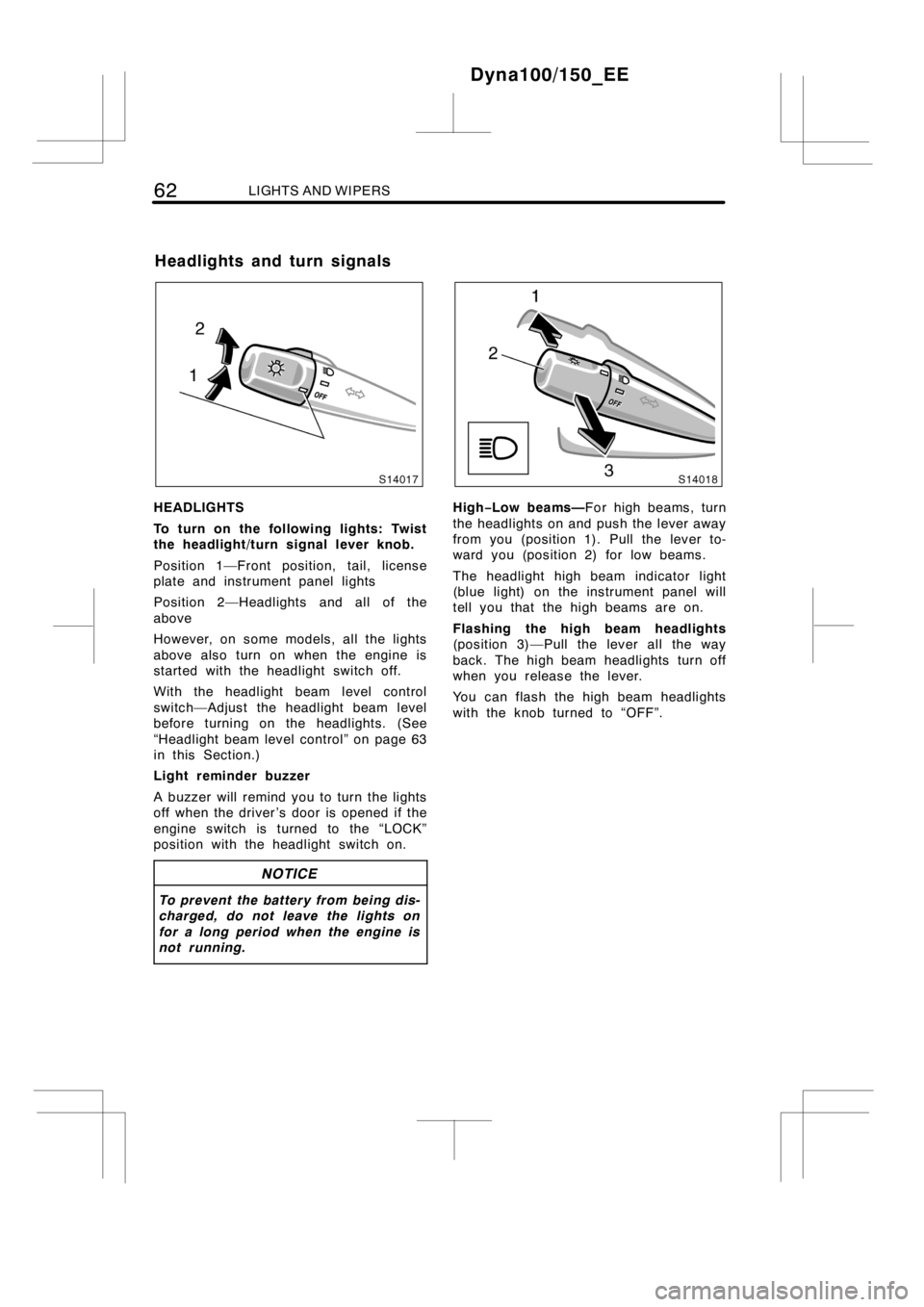Page 67 of 232
LIGHTS AND WIPERS61
Section 1−4
OPERATION OF INSTRUMENTS AND
CONTROLS
Lights and Wipers
DHeadlights and turn signals 62..........................
DHeadlight beam level control 63.........................
DEmergency flashers 64.................................
DRear fog light 64.......................................
DInterior light 65........................................
DWindshield wipers and washer 65.......................
Dyna100/150_EE
Page 68 of 232

62LIGHTS AND WIPERS
HEADLIGHTS
To turn on the following lights: Twist
the headlight/turn signal lever knob.
Position 1—Front position, tail, license
plate and instrument panel lights
Position 2—Headlights and all of the
above
However, on some models, all the lights
above also turn on when the engine is
started with the headlight switch off.
With the headlight beam level control
switch—Adjust the headlight beam level
before turning on the headlights. (See
“Headlight beam level control” on page 63
in this Section.)
Light reminder buzzer
A buzzer will remind you to turn the lights
off when the driver ’s door is opened if the
engine switch is turned to the “LOCK”
position with the headlight switch on.
NOTICE
To prevent the battery from being dis-
charged, do not leave the lights on
for a long period when the engine is
not running.
High−Low beams—For high beams, turn
the headlights on and push the lever away
from you (position 1). Pull the lever to-
ward you (position 2) for low beams.
The headlight high beam indicator light
(blue light) on the instrument panel will
tell you that the high beams are on.
Flashing the high beam headlights
(position 3)—Pull the lever all the way
back. The high beam headlights turn off
when you release the lever.
You can flash the high beam headlights
with the knob turned to “OFF”.
Dyna100/150_EE
Headlights and turn signals
Page 69 of 232

LIGHTS AND WIPERS63
TURN SIGNALS
To signal a turn, push the headlight/
turn signal lever up or down to position
1.
The engine switch must be in the “ON”
position.
The lever automatically returns after you
make a turn, but you may have to return
it by hand after you change lanes.
To signal a lane change, move the lever
up or down to the pressure point (position
2) and hold it.
If the turn signal indicator lights (green
lights) on the instrument panel flash faster
than normal, a front or rear turn signal
bulb is burned out. See “Replacing light
bulbs” on page 205 in Section 7−3.To adjust the headlight beam level, turn
the dial.
The following list shows examples of prop-
er dial settings. For loading conditions oth-
er than those listed, adjust the dial posi-
tion so that the beam level is the same
as the one obtained according to the list
when only the driver is in the vehicle. The
higher the number of the dial position, the
lower the headlight beam level.
Always keep the headlight beam at the
proper level, or your headlights may
dazzle other road users.
Loading condition and dial position
No luggage loading (driver only) 0
Driver + full luggage loading 3
Dyna100/150_EE
Headlight beam level control
Page 132 of 232

126STARTING AND DRIVING
After high−speed or extended driving that
requires a heavy engine load, the engine
should be allowed to idle, as shown in the
chart before turning it off.
Driving condition and required idling
time
Normal city driving
Idling time—Not necessary
High−speed driving
About 80 km/h (50 mph)
Idling time—About 20 seconds
About 100 km/h (62 mph)
Idling time—About 1 minute
Steep mountain slopes or continued
driving above 100 km/h (62 mph)
Idling time—About 2 minute
NOTICE
Do not turn the engine off immediate-
ly after a heavy load has been placed
on the engine in order to prevent en-
gine damage.
It is a good idea to do a safety check
before starting out on a trip. A few min-
utes of checking can help ensure safe and
pleasant driving. Just a basic familiarity
with your vehicle is required and a careful
eye! Or, if you would like, any authorized
Toyota dealer or repairer, or another duly
qualified and equipped professional, will
be pleased to make this check for you at
a nominal cost.
CAUTION
If you make this check in an enclosed
garage, make sure there is adequate
ventilation. Engine exhaust is poison-
ous.
BEFORE STARTING THE ENGINE
Outside the vehicle
Tires (spare included).Check the pres-
sure with a gauge and look carefully for
cuts, damage, or excessive wear.
Wheel nuts.Make sure no nuts are mis-
sing or loose.
Fluid leaks.After the vehicle has been
parked for a while, check underneath for
leaking fuel, oil, water, or fluid.
Lights.Make sure the headlights, stop
lights, tail lights, turn signals and other
lights are all working. Check the headlight
aim.
Battery and cables.All the battery cells
should be filled to theproper level with
distilled water. Look for corroded or loose
terminals and a cracked case. Check the
cables for good condition and connections.
Inside the vehicle
Jack and wheel nut wrench.Make sure
you have your jack and wheel nut wrench.
Seat belts.Check that the buckles lock
securely. Make sure the belts are not
worn or frayed.
Dyna100/150_EE
Precautions for turning off
an engine with turbochargerPre−trip safety check
Page 209 of 232

DO−IT−YOURSELF MAINTENANCE: Electrical components203
Ty p e A
Good Blown
Ty p e B
Good Blown
Ty p e C
Good Blown
Instrument panel
If the headlights or other electrical
components do not work, check the
fuses. If any of the fuses are blown,
they must be replaced.
See “Fuse locations” on page 182 in Sec-
tion 7−1 for locations of the fuses.
Turn the engine switch and inoperative
component off. Pull the suspected fuse
straight out and check it.
Determine which fuse may be causing the
problem. The lid of the fuse box shows
the name of the circuit for each fuse. See
page 219 in Section 8 for the functions
controlled by each circuit.
Type A fuses can be pulled out by the
pull−out tool. The location of the pull−out
tool is shown in the illustration.
If you are not sure whether the fuse has
blown, try replacing the suspected fuse
with one that you know is good.
If the fuse has blown, push a new fuse
into the clip.
Only install a fuse with the amperage rat-
ing designated on the fuse box lid.
If you do not have a spare fuse, in an
emergency you can pull out the “CIG”,
“DOME” or “A/C” fuse, which may be dis-
pensable for normal driving, and use it if
its amperage rating is the same.
Dyna100/150_EE
Checking and replacing fuses
Page 211 of 232

DO−IT−YOURSELF MAINTENANCE: Electrical components205
The following illustrations show how to
gain access to the bulbs. When replacing
a bulb, make sure the engine switch and
light switch are off. Use bulbs with the
wattage ratings given in the table.
CAUTION
DTo prevent burning yourself, do not
replace the light bulbs while they
are hot.
DHalogen bulbs have pressurized gas
inside and require special handling.
They can burst or shatter if
scratched or dropped. Hold a bulb
only by its plastic or metal case.
Do not touch the glass part of a
bulb with bare hands.
NOTICE
Only use a bulb of the listed type.
The inside of the lens of exterior lights
such as headlights may temporarily fog up
when the lens becomes wet in the rain or
in a car wash. This is not a problem
because the fogging is caused by the
temperature difference between the outside
and inside of the lens, just like the
windshield fogs up in the rain. However, if
there is a large drop of water on the
inside of the lens, or if there is water
pooled inside the light, contact any
authorized Toyota dealer or repairer, or
another duly qualified and equipped
professional.Light bulbs
WTy p e
Headlights60/55A
Front position lights21/5B
Front turn signal lights21B
Side turn signal lights21B
Rear turn signal lights21B
Stop/tail lights21/5B
Back−up lights21B
Rear fog light21B
License plate lights10B
Interior light10C
A: H4 halogen bulbs
B: Single end bulbs
C: Double end bulbs
Dyna100/150_EE
Replacing light bulbs—
Page 212 of 232
206DO−IT−YOURSELF MAINTENANCE: Electrical components
1. Single cab models: Tilt the cab. (See
“Tilt cab” on page 18 in Section 1−2
for details.)
Unplug the connector.
If the connector is tight, wiggle it.2. Remove the rubber cover.
Dyna100/150_EE
—Headlights
Page 225 of 232

SPECIFICATIONS219
Instrument panel
Left side of the vehicle
Fuses (type A)
1. CIG 15 A:Cigarette lighter
2. DOOR 30 A:Power door locksystem
3. IG1−NO.2 10 A:Gauges and meters,
service reminder indicators and warning
buzzer, back−up lights, back buzzer
4. WIP 30 A: Windshield wipers and
washer
5. A/C 10 A:Air conditioningsystem
6.IG110A:Back−up lights, back buzzer
7. TRN 10 A:Turn signal lights, emergen-
cy flashers
8. ECU−IG 10 A:Anti−lock brake system9. RR−FOG 10 A:Rear fog light
10. OBD 10 A:On−board diagnosissystem
11 . D O M E 1 0 A :Interior lights
12. ECU−B10A:Headlights, tail lights
13. TAIL 15 A:Tail lights, front position
lights, license plate lights, instrument
panel lights, rear fog light
14. H−LP LL 10 A (vehicle with daytime
running light system):Left−hand
headlight (low beam)
15. H−LP RL 10 A (vehicle with daytime
running light system):Right−hand
headlight (low beam)
16. H−LP LH 10 A (vehicle with daytime
running light system) or H−LP LH 15
A (vehicle without daytime running
light system):Left−hand headlight
(high beam)
17. H−LP RH 10 A (vehicle with daytime
running light system) or H−LP RH 15
A (vehicle without daytime running
light system):Right−hand headlight
(high beam)
18. HORN 10 A:Horns
19. HAZ 10 A:Emergency flashers
20. STOP 10 A:Stop lights
21. ST 10 A:Starting system
22.IG210A:SRS airbag system
23.A/CNO.210A:Air conditioning sys-
tem
24. SPARE 10 A:Spare fuse
25. SPARE 15 A:Spare fuse
26. SPARE 20 A:Spare fuse
27. SPARE 30 A:Spare fuse
28. FOG 15A:Fog light
29. F/HTR 30 A:Front heater
30. EFI1 10 A:Engine control system
31. ALT−S10A:Charging system, charg-
ing system warning light
32.AM210A:Engine switch
Dyna100/150_EE
Fuses